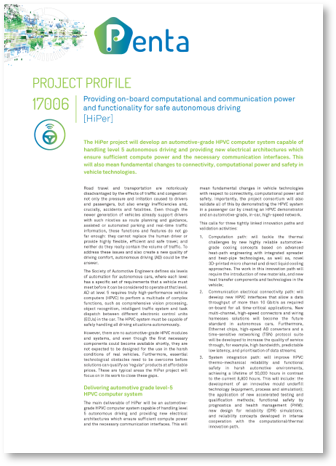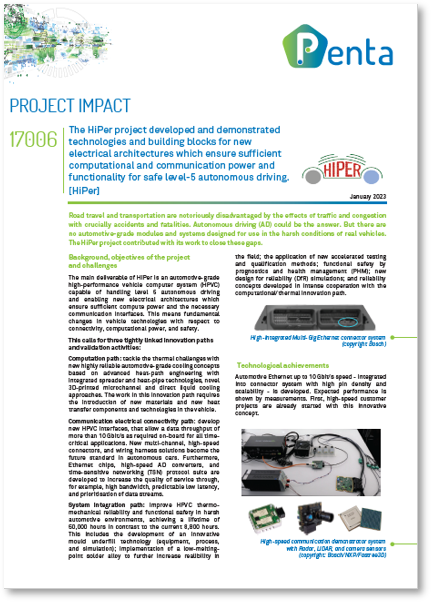Call :
PENTA Call 3
Project status :
Completed
Key application areas
 Transport & Smart Mobility
Transport & Smart Mobility  Safety & Security
Safety & Security Essential capabilities
 Systems and Components Architecture, Design & Integration
Systems and Components Architecture, Design & Integration  ECS Process Technology, Equipment, Materials & Manufacturing
ECS Process Technology, Equipment, Materials & Manufacturing
PARTNER
Advanced Packaging Center BV / Boschman Technologies BV / CWM - Chemnitzer Werkstoffmechanik GmbH / Delft University of Technology / Dynardo GmbH / Eindhoven University of Technology / Fastree3D BV / Fraunhofer Institute for Electronic Nano Systems / GLÜCK Industrie-Elektronik GmbH / IMEC / Interflux Electronics NV / Materialise NV / NXP Semiconductors Germany GmbH / NXP Semiconductors Netherlands BV / Robert Bosch GmbH / Technical University of Chemnitz / Volkswagen Group
Advanced Packaging Center BV / Boschman Technologies BV / CWM - Chemnitzer Werkstoffmechanik GmbH / Delft University of Technology / Dynardo GmbH / Eindhoven University of Technology / Fastree3D BV / Fraunhofer Institute for Electronic Nano Systems / GLÜCK Industrie-Elektronik GmbH / IMEC / Interflux Electronics NV / Materialise NV / NXP Semiconductors Germany GmbH / NXP Semiconductors Netherlands BV / Robert Bosch GmbH / Technical University of Chemnitz / Volkswagen Group
Countries involved
 Netherlands
Netherlands  Germany
Germany  Belgium
Belgium Project leader(s)
Frank PelzKey project dates
June 24, 2019 to Dec 31, 2022The HiPer project developed and demonstrated technologies and building blocks for new electrical architectures which ensure sufficient computational and communication power and functionality for safe level-5 autonomous driving. [HiPer]
Road travel and transportation are notoriously disadvantaged by the effects of traffic and congestion with crucially accidents and fatalities. Autonomous driving (AD) could be the answer. But there are no automotive-grade modules and systems designed for use in the harsh conditions of real vehicles. The HiPer project contributed with its work to close these gaps.
Background, objectives of the project and challenges
The main deliverable of HiPer is an automotive-grade high-performance vehicle computer system (HPVC) capable of handling level 5 autonomous driving and enabling new electrical architectures which ensure sufficient compute power and the necessary communication interfaces. This means fundamental changes in vehicle technologies with respect to connectivity, computational power, and safety.
This calls for three tightly linked innovation paths and validation activities:
Computation path: tackle the thermal challenges with new highly reliable automotive-grade cooling concepts based on advanced heat-path engineering with integrated spreader and heat-pipe technologies, novel 3D-printed microchannel and direct liquid cooling approaches. The work in this innovation path requires the introduction of new materials and new heat transfer components and technologies in the vehicle.
Communication electrical connectivity path: develop new HPVC interfaces, that allow a data throughput of more than 10 Gbit/s as required on-board for all timecritical applications. New multi-channel, high-speed connectors, and wiring harness solutions become the future standard in autonomous cars. Furthermore, Ethernet chips, high-speed AD converters, and time-sensitive networking (TSN) protocol suite are developed to increase the quality of service through, for example, high bandwidth, predictable low latency, and prioritisation of data streams.
System integration path: improve HPVC thermomechanical reliability and functional safety in harsh automotive environments, achieving a lifetime of
50,000 hours in contrast to the current 8,800 hours. This includes the development of an innovative mould underfill technology (equipment, process,
and simulation); implementation of a low-meltingpoint solder alloy to further increase reliability in the field; the application of new accelerated testing and qualification methods; functional safety by prognostics and health management (PHM); new design for reliability (DfR) simulations; and reliability concepts developed in intense cooperation with the computational/thermal innovation path.

(copyright Bosch)
Technological achievements
Automotive Ethernet up to 10 Gbit/s speed – integrated into connector system with high pin density and scalability – is developed. Expected performance is shown by measurements. First, high-speed customer projects are already started with this innovative concept.
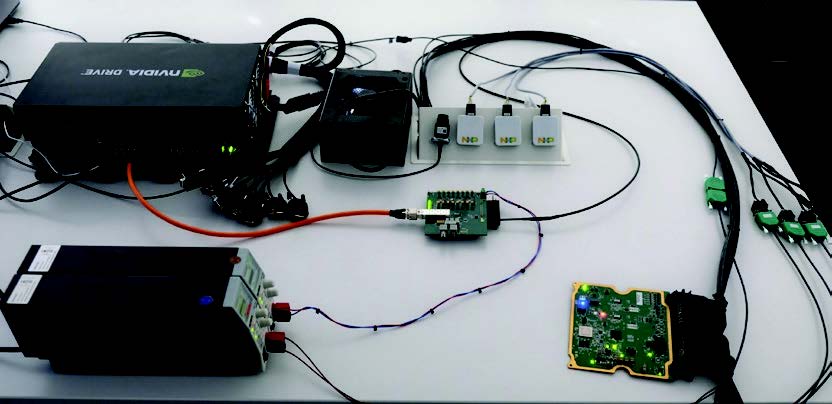
with Radar, LiDAR, and camera sensors
(copyright: Bosch/NXP/Fastree3D)
A communication demonstrator was built-up to show evidence, that all the developed building blocks work together with the required high-speed performance (Radar, LiDAR sensor, electronic components for Ethernet, Multi-Gig-connector interface, next generation of time-sensitive network communication devices with new analysis tool suite (e.g. routing 1.6x faster).
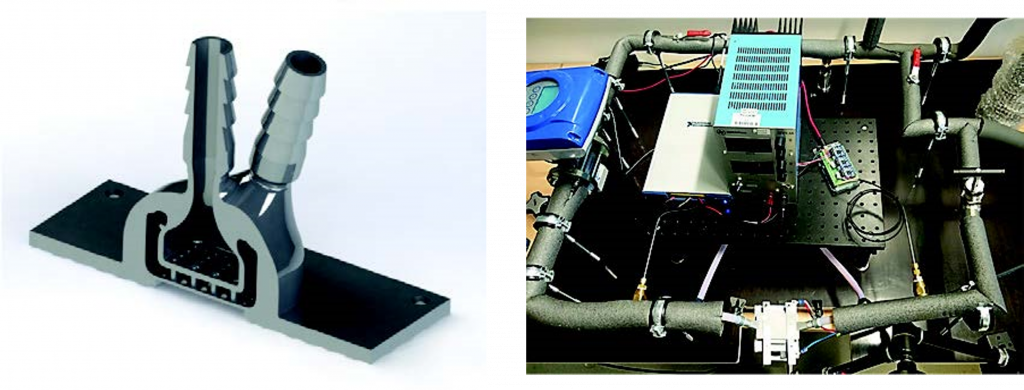
impingement cooler and automotive-grade test stand
(copyright IMEC/Materialise/TUC)
Automotive-grade liquid coolers were designed and manufactured e.g. a new type of 3D printed coolers, vapor chamber, multi-jet impingement, and
microchannel cooler. These are now ready for products.
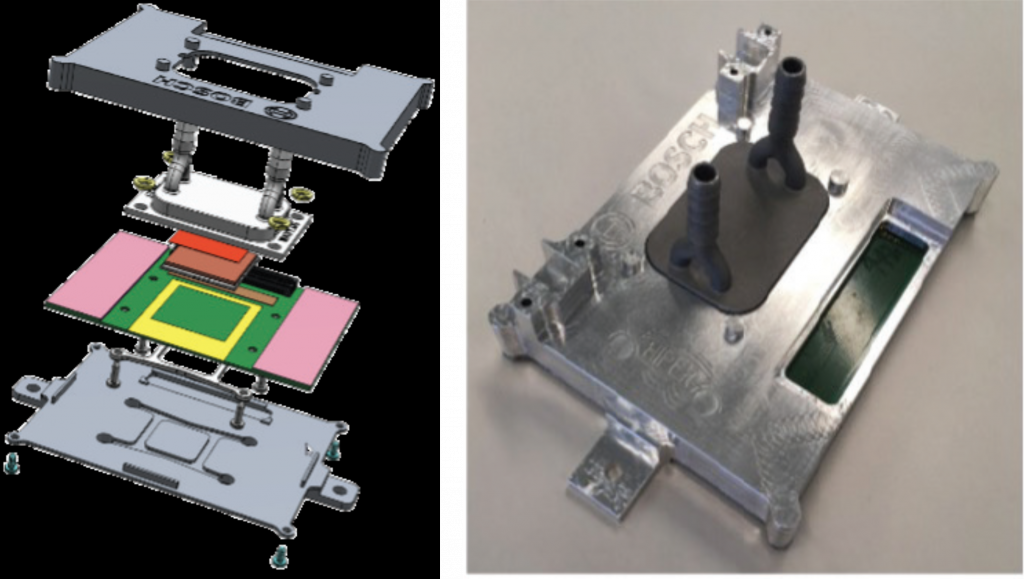
3D-printed heat sink, and new mounting system with
rubber springs (copyright Bosch)
New concepts for miniaturized heat sinks have been developed. These heat sinks have the smallest possible footprint and a small box volume with maximum heat transfer performance and defined pressure loss. A reliable mounting system with rubber springs was implemented for these heat sinks. New algorithmic developments with thermal and mechanical test cases performed, validated in a special automotive-grade test device to prove the performance. After the HiPer project deeper understanding, guidelines, an automotive-grade test stand, and cooler ranking are available. The right heat path technologies can now be efficiently tailored for products.
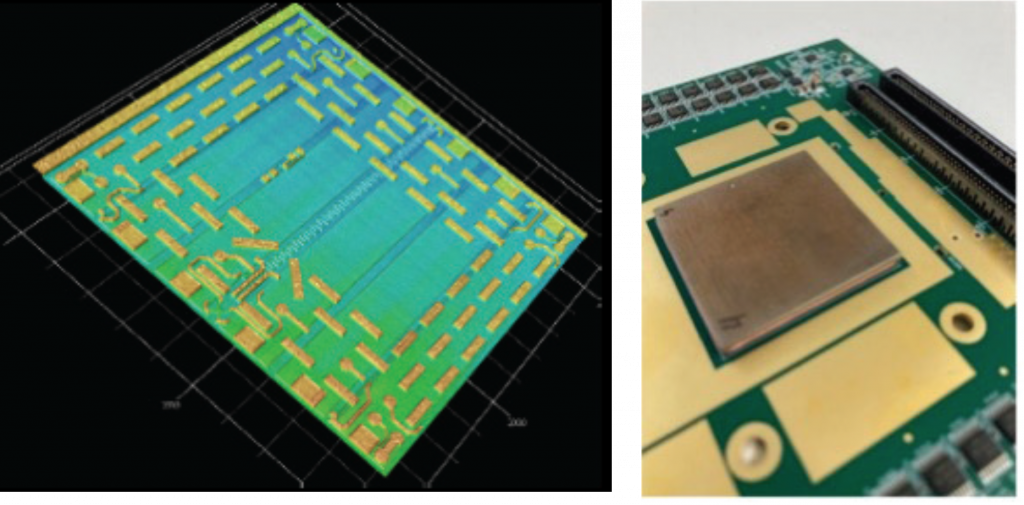
of GPU/CPUs (copyright TU Delft / Bosch)
A modular thin-film thermal test chip was developed and manufactured with improved power density, power homogeneity, & temperature accuracy to gain detailed knowledge about the component behaviour of GPU/CPUs. In this context, virtual design and new measurement methodology for large area arrays mounted in systems were applied.
Solder reliability simulation and validation measurements for low-melting soldered assemblies were also analysed.
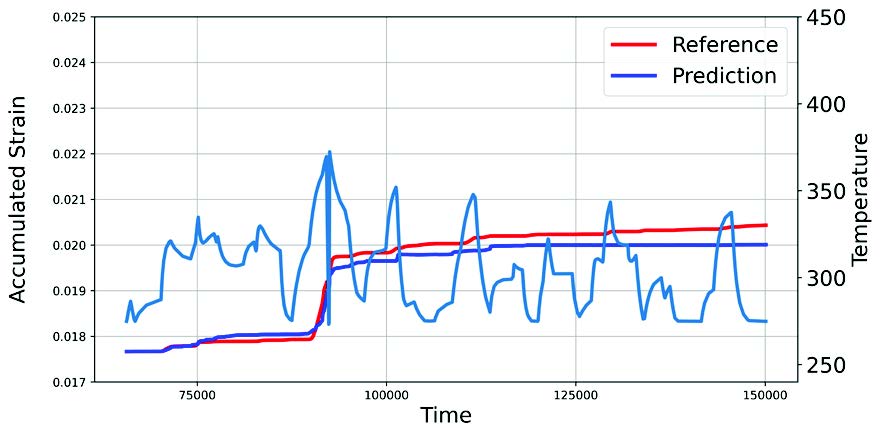
(copyright Bosch)
First Compact digital twin for thermo-mechanical loading conditions available, which enables hybrid Prognostic Health Management approach and predictive maintenance, 60,0000x faster than FEM simulation, high accuracy > 90%, and 24x computational power needed. HiPer contributes a big step forward e.g. to the target for automatic spare parts ordering in vehicles.
Market Potential
According to Markets-and-Markets 2022 “Self-driving cars market – global forecast to 2030”, the global self-driving car market is expected to expand at a CAGR of 13.3%, leading to a global number of 62.4 million self-driving cars by 2030 [1]. By creating the key technologies required for Autonomous
Driving cars – the HiPer project enables European car manufacturers to offer new efficient mobility solutions and enables the European automotive
industry to stay at the leading edge of this worldwide market.
The results from HiPer are not only applicable to the automotive industry but also to other industries with electronic control units.
Societal & Economic Impact
It is again to be highlighted that, the HiPer results have provided the needed building blocks to be able to offer real-world self-driving vehicles
(‘Autonomous Driving on Level 5 automation’). Apart from the individual benefits for the project partners, European society will massively benefit
from Autonomous Driving technologies: reduced numbers of accidents and fatalities; better deployment of existing road infrastructure through harmonised and increased traffic flows; and a new quality in driving comfort and reduced fuel consumption and emissions. The developed miniaturized high-speed interfaces and the compact cooling system will contribute to the car weight reduction, fulfilling the environmental targets. Europe will also benefit economically from the wealth generated by the continuing success of its automotive industry – in which it has a leading
position that must be defended.
A deeper understanding of the lifetime behavior of electronic components with building up digital twins is not only beneficial for safe secure HPVCs. The approaches combined with AI can also be applied in non-automotive business areas e.g. for early warnings or spare part ordering; new services will be enabled that are not even imaginable today.
Patents, Standardisation, Publications
In total 7 patents in the domain of the HiPer topics are in the application or already granted. Standardization organisations like IEEE, OPEN, and Automotive SerDes Alliances will benefit from the collected practical results of the HiPer project mainly, through the confirmed feasibility of the technologies, in particular, to standardise new functions or efficiency improvements. Over 20 publications at internal conferences, workshops, and in the journal were created. 3 dedicated HiPer workshops at European conferences were performed as well as several workshops with the main focus on small and medium enterprises. Additionally, 4 Ph.D. and 7 master theses will leverage the results.
Future Developments
4 follow-up projects have already started or are planned. The good results and the excellent collaboration have led to the decision that many HiPer project members will work together on this Xecs follow-up project ‘e2LEAD’. Further topics in highspeed communication, cooling concepts and reliability prediction, digital twins are addressed.
[1] Source: https://www.businesswire.com/news/home/20220215005655/en/Self-Driving-Cars-Market-Global-Forecastto-2030-Increasing-Demand-for-Level-1-and-Level-2-Cars-and-Rising-Investment-in-Development-of-Level-4-and-Level-5-Cars-Will-Propel-Market—ResearchAndMarkets.com- 15 February 2022- ResearchAndMarkets.com


